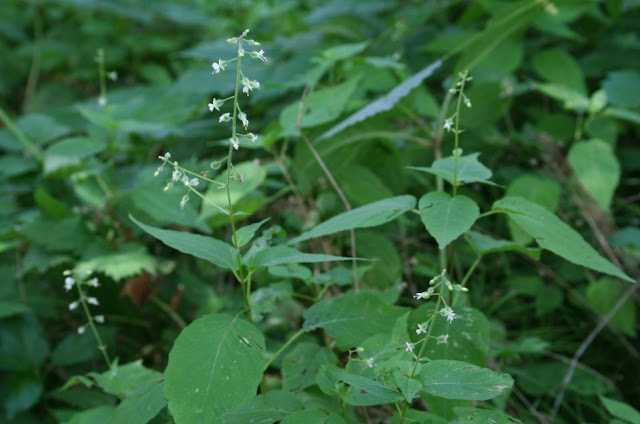 |
| Enchanter's Nightshade, Circaea lutetiana L., in July. |
Enchanter’s Nightshade, Circaea lutetiana, doesn’t get a lot of positive attention. This native plant of the forest floor is often regarded as a weed, something to remove in favor of less aggressive, more attractive species. Its appearance is modest at best. Its name, though, suggests something less humble. What’s the story?
Mostly Inconspicuous
Compared to showier spring wildflowers, this summer bloomer
isn’t much to look at. Individual stems grow up to a foot tall, sometimes
longer, with opposite, egg-shaped leaves and smooth stems. The plant spreads
with rhizomes to form colonies, especially in disturbed areas or canopy gaps where
more light reaches the understory.
In July and August, Enchanter’s Nightshade produces small,
white flowers on racemes. If not for their masses, the flowers would be easy to
miss. Each is just a few millimeters across, smaller than an eraser on the end
of a pencil, with a mere two sepals, two petals, two stamens and one pistil. They're beautiful, but minimal.
Small, pear-shaped fruits follow. They’re covered with
hooked hairs that grab onto anything that passes – shoelaces, socks, pants, fur. It’s
impossible to ignore them, but it’s not the kind of attention that inspires admiration.
A few steps through a patch catches a
load of little stickers.
 |
| Flowers and fruits of Enchanter's Nighshade. |
From Meek to Mythical
The ”enchanter” in the plant’s
name is Circe, the sorceress of Greek myth. According to legend, she used herbs
and potions to turn people into pigs, lions and wolves. One of the herbs in her concoctions was Circaea lutetiana, the plant that now bears her name. The species
name lutetiana also reflects the plant’s supposed use in sorcery.
Lutetia was the ancient city that is now Paris, France, called “the city of
witches” in some accounts.
Studies of the plant’s chemistry don’t find much that is
bewitching. Although it’s called a nightshade, it’s not a traditional member of
that group. Nightshades are usually plants in the tomato family, Solanaceae
(solan-AY-see-ee). In terms of chemistry, this family is known for its higher
quantities of alkaloids, compounds that have uncertain roles in plants but a
variety of physiological effects in humans. Some alkaloids, such as opium from
poppies and cocaine from coca bushes, are mind-altering, euphoric and addictive.
In contrast, Enchanter’s Nightshade is in the evening
primrose family, Onagraceae. Its chemistry features flavonoids, molecules that have various functions in plants. Some are pigments – the
red of raspberries, for example – while others regulate growth or protect
against UV radiation, among other roles (1, 2). Like alkaloids, flavonoids have
potential use in medicine, but they aren’t mind-altering, and they aren’t associated
with euphoria. In fact, they’re relatively benign. Circe might have worked some
legendary magic, but Enchanter’s Nightshade wouldn’t have put much punch in her
potions.
Adaptation and Potential Advantage
The ”nightshade” in its name, then, probably comes from its
shady habitat. Like other plants of the forest floor, Enchanter’s Nightshade is
adapted to an environment with limited light. One adaptation is its ability to
colonize gaps or disturbances by growth if its rhizomes, underground stems that
produce shoots along their length.
Unlike other clonal plants, Enchanter’s Nightshade holds some of that
ability in reserve. Its new rhizomes do not produce shoots. Instead, they lengthen
and branch until late summer, when some of them produce small tubers called
hibernacles at their tips. Eventually the hibernacles are separated from the
parent plant and from each other and go dormant. They are the vegetative
equivalent of seeds, but with faster development the following spring to form patches of upright stems. In higher light intensities, this growth can be vigorous (3).
 |
| Near the end of the season, tips of rhizomes (arrow) develop into tuber-like hibernacles. The hibernacles overwinter and resume growth next spring, forming new rhizomes and above ground shoots. |
Although some consider that growth weedy and aggressive, it could prove useful. Restorationists are looking at Enchanter’s Nightshade and other “weedy natives” as potential cover crops where severe infestations of invasive plants have been removed. By shading out or otherwise competing with invasive plants that can reoccupy an area, Enchanter’s Nightshade may give native communities an improved chance to recover (4).
It’s not magic, but it could be transformative. If research shows this to be an effective restoration technique, Enchanter’s
Nightshade could help convert a landscape from diminished to diverse.
References
(1) Falcone Ferreyra, M.L,
Rius, S.P., and Casati, P. (2012). Flavonoids: biosynthesis, biological
functions, and biotechnological applications. Frontiers in Plant Science volume
33, article 222. https://doi.org/10.3389/fpls.2012.00222.
(2) Panche, A. N., Diwan, A. D., and Chandra, S. R. (2016).
Flavonoids: an overview. Journal of nutritional science, 5, e47. https://doi.org/10.1017/jns.2016.41
(3) Verburg, R.W., and During, H.J. (1998). Vegetative
propagation and sexual reproduction in the woodland understorey pseudo-annual Circaea
lutetiana L. Plant Ecology 134: 211-224. https://doi.org/10.1023/A:1009741102627.
(4) Reinartz, J., White, M., and Hapner, J. No date. A role for
native weeds and aggressive plants for replacing (or competing with) invasives
in badly degraded areas. Invasive Plants Association of Wisconsin. Accessed
online on 7/13/22 at A Role
for Native Weeds - Invasive Plants Association of Wisconsin (ipaw.org).



